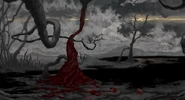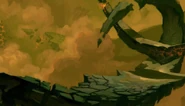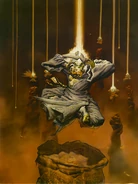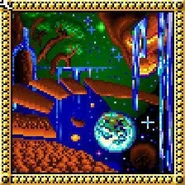The Ever-Changing Chaos of Limbo was an Outer plane in the Great Wheel cosmology model that embodied the chaotic neutral alignment.[10][6]
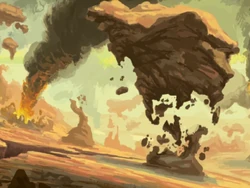
A chaotic landscape.
The plane of Warrior's Rest in the World Tree cosmology was similar to Limbo in many ways but not quite as morphic.[11] The batrachi formed a realm in Limbo called the Supreme Throne[12] which became its own plane in the World Tree cosmology model.[13] Limbo was lost during the Spellplague and may have fallen into the Elemental Chaos.[note 1]
Walk the air;
Drink the earth;
Warm your hands at the water.
Description[]
This plane was supreme chaos, a twisting, quicksilver place filled with bits and pieces of rocks, trees, the four elements, entire landscapes, strong winds, and random pockets of liquid, solid, or gas. Sentient beings could dampen down the chaos to livable levels and produce a safe environment as long as they maintained concentration. The size of a safe zone was directly related to the intelligence of the individual controller.[8] Demigods and more powerful beings did not have this burden and indeed could create realms that survived even if they left Limbo.[1] Gravity operated only between solid objects that touched each other and had about the same strength as on most Prime Material Planes. Thrown objects would fly straight until they hit a solid object. Objects with no momentum would hang in space until contacted by something solid.[8]

More chaos.
As described by the Great Wheel cosmology, Limbo had five layers that were nearly indistinguishable from each other. The first four layers were named for the chief race or deity that were most often found there. The fifth layer was referred to as the layer of Lost Gods.[1]
A branch of Yggdrasil, the World Ash, connected the first layer of Ysgard to Limbo. It was a trajectory regularly chosen by the Great Modron March.[15]
A rare type of substance was exported out of Limbo called shiftspice. It was sold in small packets and consumed through dipping and licking wetted fingers. Each dip tasted differently. This exotic spice could be purchased as far from Limbo as Sigil, the City of Doors.[16]
Gith and Slaad[]
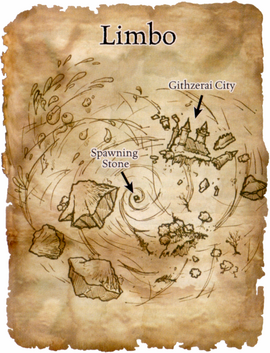
A representation of a region of Limbo, according to the Great Wheel Cosmology. Hovering over the map will reveal main features. Clicking will link to the article for that location.
The slaad were likely natives of Limbo and the githzerai were immigrants (or refugees, if you ask the githyanki) and the first layer was named for them.[1] This layer was strategically important because of its connections to Gladsheim, Concordant Opposition, Pandemonium, and the Astral plane.
Susanowo[]
Named after a deity from the country of Japan on Earth,[18] he ruled a spherical bubble half filled with sea water and aquatic life and churned by storms of his making.[19]
Agni[]
Named after a deity from the country of India on Earth,[20] he resided in a sphere of pure flame that floated through the layers at his will.[19]
Indra[]
Also from India,[21] Indra's sphere was half filled with enchanted milk and his palace stood on an island-sized tortoise (or possibly a tortoise-shaped island).[19]
Lost Gods[]
It was unknown if any race or deity favored this layer.[1]
Cosmology[]
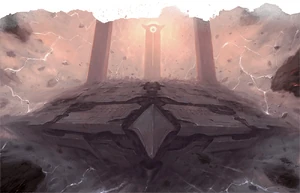
A githzerai fortress city.
Afterlife[]
When souls arrived in the plane of Limbo, they were not allowed to manifest in some form but rather were absorbed into the matter of the plane. Occasionally a collection of spirits would become powerful enough to form what was called a chaos elemental, not to be confused with a being from the elemental planes.[19]
History[]
According to a thrall captured by mind flayers of Oryndoll beneath Andalbruin, Limbo was the plane to which the batrachi retreated in −31,500 DR. There, they founded a realm called the Supreme Throne.[12] Cyric, as a result of his insanity, forcefully moved the fortress into his own divine realm, which became a fiendish plane according to the World Tree cosmology,[13] or a realm in Cocytus according to the Great Wheel cosmology.[22][23]
Notable Locations[]
Uh huh.
I suppose you want to know the Lady of Pain's address too.
I'd give it to you, but I promised her I wouldn't.
The realms of the powers that resided in Limbo floated through the various layers at will and so are listed here in no particular order.
- The slaad lords Ssendam and Ygorl maintained realms most often found in the first layer but away from areas not under their control. Ssendam's citadel is a golden castle, while Ygorl's realm is a chain of carved spheres that whirl about.[19]
- The githzerai formed hamlets, villages, and two large cities out of the chaos. The first one was know as Shra'kt'lor, which was the center of their military might, while the second known as the Floating City or Citadel of Gith and was a religious center of their race. Both of them were ruled over by Zaerith Menyar-Ag-Gith (the Great Githzerai).[19][25]
- Fennimar was the realm of Fenmarel Mestarine before moving to Arvandor.[26][27] Shevarash, the Black Archer, also often stayed there.[28]
- Targus, the Netherese god of war, lived here,[29] before moving to Pandemonium under his new name of Garagos.[30]
- Tempus Foehammer, Lord of Battles once lived in Limbo.[31][32] Knight's Rest was the name of his realm[33] which later became its own plane named Warrior's Rest in the World Tree cosmology model.[34]
- Leira, the Lady of the Mists, once made her home called the Courts of Illusion here.[35][36][37]
- Tapann, the patron deity of korreds once made his home here.[38]
- Mystryl, the Mother of All Magic, lived on this plane in her domain called Dweomertor[39] until her death in −339 DR.[40]
- Astilabor, the Hoardmistress of the Draconic pantheon, was reputed to have a lair hidden somewhere in Limbo that contained more wealth than that found on all the planets of Realmspace.[41][42][note 2]
- Kereska, the draconic "Light of Magic", resided in Limbo.[43][42]
- Agni, the chaotic Vedic fire deity, had a mutable realm named Swarga here together with his fellow Lords of Creation Indra and Vayu.[44][45]
Appendix[]
Notes[]
- ↑ This statement is partially speculation, but according to this comment on page 346 of the One and Only Ask the Realms Designers Thread, Limbo just vanished. Also, on page 15 of the Manual of the Planes 4th edition, it compares Limbo with the Elemental Chaos. Furthermore, on page 274 of the Monster Manual 5th edition, the Ever-Changing Chaos of Limbo is described as "a tumult of fire, water, earth, and wind".
- ↑ The more recent but Core source Races of the Dragon places Astilabor in the Outlands instead.
Gallery[]
Appearances[]
Novels & Short Stories
Video Games
References[]
- ↑ 1.0 1.1 1.2 1.3 1.4 1.5 Jeff Grubb (July 1987). Manual of the Planes 1st edition. (TSR), p. 98. ISBN 0880383992.
- ↑ Jeff Grubb (April 1987). “Plane Speaking: Tuning in to the Outer Planes”. In Roger E. Moore ed. Dragon #120 (TSR, Inc.), pp. 42–43.
- ↑ Jeff Grubb (July 1987). Manual of the Planes 1st edition. (TSR), p. 62. ISBN 0880383992.
- ↑ Jeff Grubb, Bruce R. Cordell, David Noonan (September 2001). Manual of the Planes 3rd edition. (Wizards of the Coast), p. 49. ISBN 0-7869-1850-8.
- ↑ Mike Mearls, Jeremy Crawford, Christopher Perkins, James Wyatt (2014). Dungeon Master's Guide 5th edition. (Wizards of the Coast), p. 47. ISBN 978-0786965622.
- ↑ 6.0 6.1 Jeff Grubb (July 1987). Manual of the Planes 1st edition. (TSR), p. 73. ISBN 0880383992.
- ↑ Jeff Grubb (July 1987). Manual of the Planes 1st edition. (TSR), p. 75. ISBN 0880383992.
- ↑ 8.0 8.1 8.2 Jeff Grubb (July 1987). Manual of the Planes 1st edition. (TSR), p. 97. ISBN 0880383992.
- ↑ Jeff Grubb, Bruce R. Cordell, David Noonan (September 2001). Manual of the Planes 3rd edition. (Wizards of the Coast), pp. 92–96. ISBN 0-7869-1850-8.
- ↑ Mike Mearls, Jeremy Crawford, Christopher Perkins, James Wyatt (2014). Dungeon Master's Guide 5th edition. (Wizards of the Coast), p. 58. ISBN 978-0786965622.
- ↑ Richard Baker, James Wyatt (March 2004). Player's Guide to Faerûn. (Wizards of the Coast), p. 169. ISBN 0-7869-3134-5.
- ↑ 12.0 12.1 Brian R. James, Ed Greenwood (September 2007). The Grand History of the Realms. Edited by Kim Mohan, Penny Williams. (Wizards of the Coast), p. 5. ISBN 978-0-7869-4731-7.
- ↑ 13.0 13.1 Richard Baker, James Wyatt (March 2004). Player's Guide to Faerûn. (Wizards of the Coast), p. 163. ISBN 0-7869-3134-5.
- ↑ Wolfgang Baur and Lester Smith (1994-07-01). “The Travelogue”. In Michele Carter ed. Planes of Chaos (TSR, Inc), p. 25. ISBN 1560768746.
- ↑ Monte Cook, Colin McComb (1997-10-28). The Great Modron March. Edited by Michele Carter. (TSR, Inc.), p. 62. ISBN 0-7869-0648-0.
- ↑ Black Isle Studios (December 1999). Designed by Chris Avellone. Planescape: Torment. Interplay.
- ↑ Black Isle Studios (December 1999). Designed by Chris Avellone. Planescape: Torment. Interplay.
- ↑ James Ward, Robert J. Kuntz (August 1980). Deities & Demigods. Edited by Lawrence Schick. (TSR, Inc.), p. 84. ISBN 0-935696-22-9.
- ↑ 19.0 19.1 19.2 19.3 19.4 19.5 Jeff Grubb (July 1987). Manual of the Planes 1st edition. (TSR), p. 99. ISBN 0880383992.
- ↑ James Ward, Robert J. Kuntz (August 1980). Deities & Demigods. Edited by Lawrence Schick. (TSR, Inc.), p. 76. ISBN 0-935696-22-9.
- ↑ James Ward, Robert J. Kuntz (August 1980). Deities & Demigods. Edited by Lawrence Schick. (TSR, Inc.), p. 75. ISBN 0-935696-22-9.
- ↑ Colin McComb (October 1996). On Hallowed Ground. Edited by Ray Vallese. (TSR, Inc.), p. 168. ISBN 0-7869-0430-5.
- ↑ Julia Martin, Eric L. Boyd (March 1996). Faiths & Avatars. (TSR, Inc.), pp. 51–52. ISBN 978-0786903849.
- ↑ Monte Cook, Colin McComb (1997-10-28). The Great Modron March. Edited by Michele Carter. (TSR, Inc.), p. 64. ISBN 0-7869-0648-0.
- ↑ Wolfgang Baur and Lester Smith (1994-07-01). “The Book of Chaos”. In Michele Carter ed. Planes of Chaos (TSR, Inc), pp. 75–76. ISBN 1560768746.
- ↑ Eric L. Boyd (November 1998). Demihuman Deities. Edited by Julia Martin. (TSR, Inc.), p. 111. ISBN 0-7869-1239-1.
- ↑ Richard Baker, James Wyatt (March 2004). Player's Guide to Faerûn. (Wizards of the Coast), p. 143. ISBN 0-7869-3134-5.
- ↑ Eric L. Boyd (November 1998). Demihuman Deities. Edited by Julia Martin. (TSR, Inc.), pp. 129–130. ISBN 0-7869-1239-1.
- ↑ slade, Jim Butler (October 1996). “Encyclopedia Arcana”. In Jim Butler ed. Netheril: Empire of Magic (TSR, Inc.), p. 33. ISBN 0-7869-0437-2.
- ↑ Eric L. Boyd (September 1997). Powers & Pantheons. Edited by Julia Martin. (TSR, Inc.), p. 18. ISBN 978-0786906574.
- ↑ Ed Greenwood, Jeff Grubb (August 1987). “Cyclopedia of the Realms”. In Karen S. Martin ed. Forgotten Realms Campaign Set (TSR, Inc.), p. 15. ISBN 0-88038-472-7.
- ↑ Jeff Grubb and Ed Greenwood (1990). Forgotten Realms Adventures. (TSR, Inc), p. 32. ISBN 0-8803-8828-5.
- ↑ Julia Martin, Eric L. Boyd (March 1996). Faiths & Avatars. (TSR, Inc.), p. 158. ISBN 978-0786903849.
- ↑ Richard Baker, James Wyatt (March 2004). Player's Guide to Faerûn. (Wizards of the Coast), p. 164. ISBN 0-7869-3134-5.
- ↑ Ed Greenwood, Jeff Grubb (August 1987). “Cyclopedia of the Realms”. In Karen S. Martin ed. Forgotten Realms Campaign Set (TSR, Inc.), p. 11. ISBN 0-88038-472-7.
- ↑ Jeff Grubb and Ed Greenwood (1990). Forgotten Realms Adventures. (TSR, Inc), p. 23. ISBN 0-8803-8828-5.
- ↑ Julia Martin, Eric L. Boyd (March 1996). Faiths & Avatars. (TSR, Inc.), p. 93. ISBN 978-0786903849.
- ↑ Ed Greenwood (March 1987). “The Ecology of the Korred”. In Roger E. Moore ed. Dragon #119 (TSR, Inc.), pp. 42–44.
- ↑ slade, Jim Butler (October 1996). “The Winds of Netheril”. In Jim Butler ed. Netheril: Empire of Magic (TSR, Inc.), p. 49. ISBN 0-7869-0437-2.
- ↑ slade, Jim Butler (October 1996). “The Winds of Netheril”. In Jim Butler ed. Netheril: Empire of Magic (TSR, Inc.), p. 12. ISBN 0-7869-0437-2.
- ↑ Nigel Findley, et al. (October 1990). Draconomicon. Edited by Mike Breault. (TSR, Inc.), p. 25. ISBN 0-8803-8876-5.
- ↑ 42.0 42.1 Dale Donovan (January 1998). Cult of the Dragon. Edited by Julia Martin. (TSR, Inc.), p. 120. ISBN 0-7869-0709-6.
- ↑ Nigel Findley, et al. (October 1990). Draconomicon. Edited by Mike Breault. (TSR, Inc.), p. 25. ISBN 0-8803-8876-5.
- ↑ Colin McComb (October 1996). On Hallowed Ground. Edited by Ray Vallese. (TSR, Inc.), pp. 154–155. ISBN 0-7869-0430-5.
- ↑ Mike Pondsmith, Jay Batista, Rick Swan, John Nephew, Deborah Christian (1988). Kara-Tur: The Eastern Realms (Volume II). (TSR, Inc), p. 105. ISBN 0-88038-608-8.
Connections[]
Battle Garde • Courts of Illusion • Dweomertor • Fennimar • Knight's Rest • Supreme Throne • Swarga
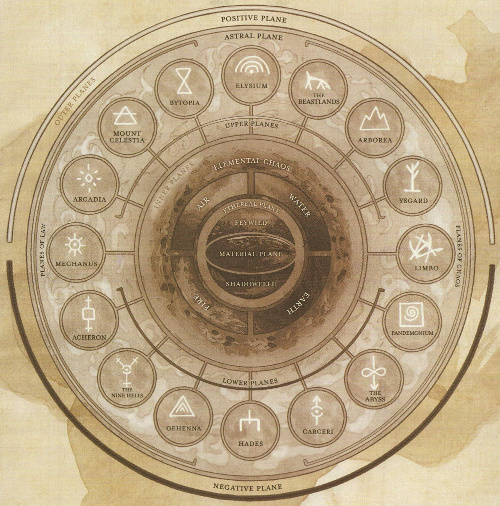
Prime Material plane • Feywild • Shadowfell • Fugue Plane
Transitive Planes: Astral Plane • Ethereal plane
Inner Planes: Elemental Plane of Air • Elemental Plane of Water • Elemental Plane of Earth • Elemental Plane of Fire • Elemental Chaos
Para-Elemental Planes: Frostfell • Swamp of Oblivion • Fountains of Creation • Great Conflagration
Quasi-Elemental Planes: Lightning • Radiance • Minerals • Steam • Vacuum • Ash • Dust • Salt
Outlands: Sigil
Outer Planes: Arcadia • Mount Celestia • Bytopia • Elysium • Beastlands • Arborea • Ysgard • Limbo •
Pandemonium • Abyss (Layers) • Carceri • Hades • Gehenna • Nine Hells • Acheron • Mechanus
Energy planes: Positive Energy plane • Negative Energy plane
Planar Pathways: Infinite Staircase • Oceanus • Mount Olympus • Styx • Yggdrasil
Far Realm
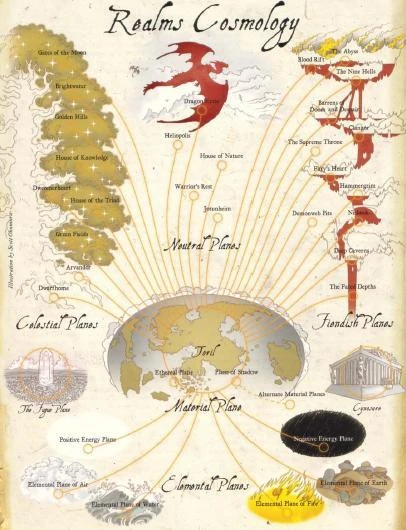
Prime Material plane • Cynosure • Fugue Plane
Transitive Planes: Astral Plane • Ethereal plane • Plane of Shadow • Spirit World
Celestial Outer Planes: Arvandor • Brightwater • Dwarfhome • Dweomerheart • Gates of the Moon • Golden Hills • Green Fields • House of Knowledge • House of the Triad
Fiendish Outer Planes: Abyss (Layers) • Barrens of Doom and Despair • Blood Rift • Clangor • Deep Caverns • Demonweb Pits • Fated Depths • Fury's Heart • Hammergrim • Nine Hells • Nishrek • Supreme Throne
Neutral Outer Planes: Dragon Eyrie • Heliopolis • House of Nature • Jotunheim • Warrior's Rest
Inner Planes: Elemental Plane of Air • Elemental Plane of Earth • Elemental Plane of Fire • Elemental Plane of Water • Positive Energy plane • Negative Energy plane
Planar Pathways: Infinite Staircase • River of Blood • World Tree
Far Realm
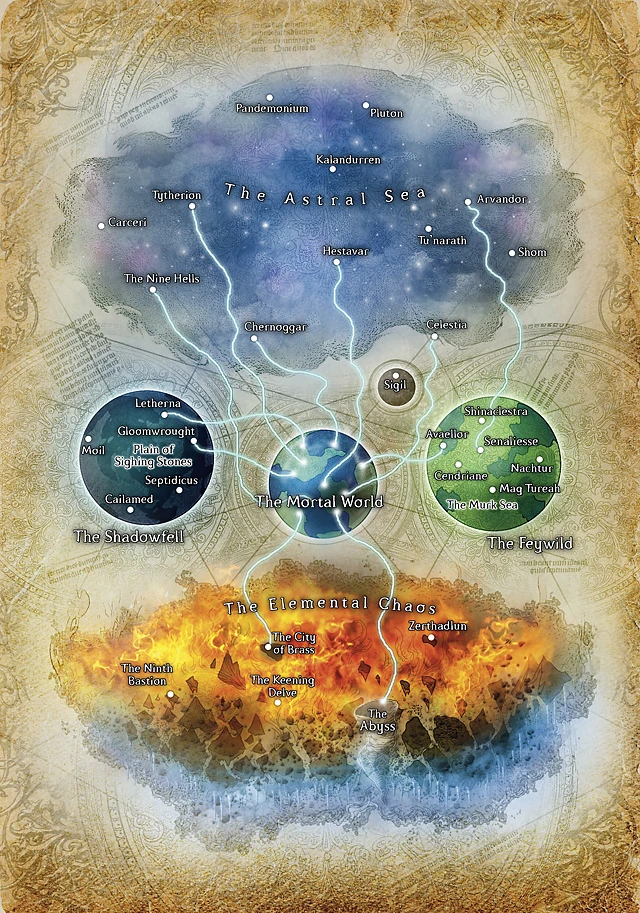
Prime Material plane
Fundamental planes: Astral Sea • Elemental Chaos
Astral dominions: Arvandor • Banehold • Celestia • Cynosure • Deep Wilds • Demonweb Pits • Dismal Caverns • Dwarfhome • Eternal Sun • Fugue Plane • Gates of the Moon • Green Fields • House of Knowledge • Nine Hells • Nishrek • Supreme Throne • Towers of Night • Tu'narath • Warrior's Rest
Elemental realms: Abyss (Layers) • City of Brass • Cresting Spires • Fimbulwinter • Hidden Realm • Muspelheim • Root Hold • Sky Home • Steading • Thraotor • Undying Pyre • Zerthadlun
Parallel planes: Feywild • Shadowfell
Anomalous planes: Far Realm

